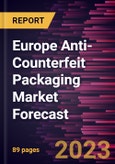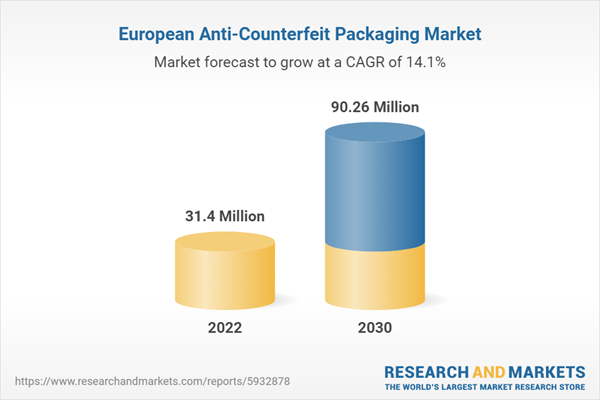Increasing Cases of Counterfeiting and Stringent Regulations Associated with Anti-counterfeit Packaging Drives Europe Anti-Counterfeit Packaging Market
Counterfeiting has become a pervasive issue in the global market, affecting various industries and posing significant challenges to governments, businesses, and consumers. Enabled by globalization, e-commerce, and advanced technology, counterfeiters exploit the complexity of supply chains and consumer demand for affordable products. Counterfeiting causes significant economic losses and job displacement, as well as jeopardizes consumer safety, undermines brand reputation, and erodes trust in the marketplaces. Between March and December 2022, Europol commenced the EU-wide operation against the illegal trade in counterfeit apparel, footwear, and accessories. Europol seized ~US$ 95 million worth of counterfeit goods - including 1,956,607 counterfeit clothes, shoes, and garments. As a result, businesses are actively seeking ways to protect their products and ensure authenticity. Anti-counterfeit packaging solutions incorporate various security features that help verify product authenticity, prevent tampering, and deter unauthorized replications, thereby reducing counterfeiting activities. These solutions often incorporate covert security features that include hidden codes, taggants, or specialized inks, which can only be authenticated using specialized devices or technologies, making it difficult for counterfeiters to replicate. Further, the stringent regulatory landscape and the efforts of industry associations and governments to combat counterfeiting have heightened the focus on anti-counterfeit packaging. Regulatory requirements in various sectors, such as tobacco, pharmaceuticals, and luxury goods, mandate the use of anti-counterfeit measures to protect consumers and maintain industry integrity. Thus, increasing counterfeiting cases and stringent government regulations are driving the demand for anti-counterfeit packaging.Europe Anti-Counterfeit Packaging Market Overview
In Europe, counterfeit products pose a significant threat to companies’ intellectual property rights. The Europe anti-counterfeit packaging market in Europe is driven by various industries, including pharmaceutical, personal care & cosmetics, food & beverages, luxury goods, electric appliances, and consumer goods, which are particularly vulnerable to counterfeiting. Consumer safety is a top priority for regulatory authorities in Europe. Governments of various countries in Europe have implemented strict regulations and standards to combat counterfeiting. For instance, the European Union has introduced regulations such as the Falsified Medicines Directive (FMD) and the Tobacco Products Directive (TPD), which require pharmaceutical and tobacco companies to implement anti-counterfeit measures. In addition, the European Union has imposed Regulation No. 3295/94 to prohibit the release for free circulation, export, re-export, or entry of counterfeit and pirated goods. Anti-counterfeit packaging helps protect consumers from consuming/using potentially harmful products by ensuring the authenticity and integrity of the packaged goods. Moreover, with the rise of e-commerce, the risk of counterfeit products has also increased. Counterfeiters use online platforms to sell fake or substandard products, which can harm consumers and legitimate businesses. According to the report by PostNord AB, Europe has the strongest market for e-commerce platforms. The report revealed that ~297 million European consumers shopped through e-commerce websites in 2021. According to the European Union Intellectual Property Office, in 2021, over 50% of counterfeit goods seized at the EU borders stemmed from e-commerce. Anti-counterfeit packaging helps protect against such illicit activities by incorporating security features that are difficult to replicate, enabling consumers to verify the authenticity of products they purchase online. Further, the advancement in anti-counterfeit technology, development of efficient inks, and rise in several trends such as smart packaging are expected to boost the Europe anti-counterfeit packaging market growth during the forecast period.Europe Anti-Counterfeit Packaging Market Revenue and Forecast to 2030 (US$ Million)
Europe Anti-Counterfeit Packaging Market Segmentation
The Europe anti-counterfeit packaging market is segmented into technology, application, and country.Based on technology, the Europe anti-counterfeit packaging market is segmented into security inks and coatings, radio frequency identification (RFID), forensic markers, tamper evident, holograms, barcode, and others. In 2022, the barcode segment registered the largest share in the Europe anti-counterfeit packaging market.
Based on application, the Europe anti-counterfeit packaging market is segmented into food and beverage; pharmaceutical; personal care and cosmetics; electrical and electronics; textile and apparel; automotive; and others. In 2022, the food and beverage segment registered the largest share in the Europe anti-counterfeit packaging market.
Based on country, the Europe anti-counterfeit packaging market is segmented into Germany, France, Italy, the UK, Russia, and the Rest of Europe. In 2022, France registered the largest share in the Europe anti-counterfeit packaging market.
Antares Vision SpA, Arjo AB, Avery Dennison Corp, Brady Corp, CCL Industries Inc, Constantia Flexibles International GmbH, Gestion Groupe Optel Inc, KURZ Transfer Products LP, and Octane5 International LLC are some of the leading companies operating in the Europe anti-counterfeit packaging market.
Table of Contents
Executive Summary
At 14.1% CAGR, the Europe Anti-counterfeit packaging market is speculated to be worth US$ 90.26 million by 2030.According to this research, the Europe anti-counterfeit packaging market was valued at US$ 31.40 million in 2022 and is expected to reach US$ 90.26 million by 2030, registering a CAGR of 14.1% from 2022 to 2030. Growing demand from pharmaceutical industry and increasing cases of counterfeiting and stringent regulations associated with anti-counterfeit packaging are the critical factors attributed to the Europe anti-counterfeit packaging market expansion.
Counterfeit pharmaceutical products are fake or unauthorized replicas of genuine medications intentionally mislabeled, adulterated, or substandard in quality. Counterfeit pharmaceutical products pose significant risks to public health and safety, leading to a growing concern among regulatory bodies, pharmaceutical companies, and consumers. The pharmaceutical industry is particularly vulnerable to counterfeiting due to the high value and demand for medications, complex global supply chains, and the potential for substantial financial gain for counterfeiters. According to Interpol, the global trade in illicit pharmaceuticals is a substantial crime area, which is valued at US$ 4.4 billion, as it attracts the involvement of organized crime groups worldwide. According to the Pharmaceutical Security Institute, in 2020, officials uncovered 4,344 incidents of counterfeiting, illegal diversion, and theft of pharmaceuticals in 137 countries. In 2022, Interpol Operation - Pangea XV with police, customs, and health regulatory authorities from 94 countries led to the seizing of US$ 11 million in illicit medicines, issuing of 200 search warrants, and shutdown or removal of over 4,000 web links - including websites and online marketplaces containing adverts for illicit products. Anti-counterfeit packaging provides measures to ensure the authenticity, traceability, and integrity of pharmaceutical products throughout the supply chain. These packaging solutions incorporate advanced technologies such as tamper-evident labels, holograms, unique serialization codes, track-and-trace systems, and RFID tags to enable product authentication and detect any signs of tampering or unauthorized handling. The implementation of anti-counterfeit packaging in the pharmaceutical industry helps combat the proliferation of counterfeit drugs, safeguards patients' well-being, maintains brand reputation, and ensures compliance with regulatory requirements. The threat of counterfeit drugs persists as the pharmaceutical market continues to expand globally. Hence, the demand for anti-counterfeit packaging solutions in the pharmaceutical industry is growing, which is driving the Europe anti-counterfeit packaging market.
On the contrary, usage complexity of anti-counterfeit packaging hurdles the growth of Europe anti-counterfeit packaging market.
Based on technology, the Europe anti-counterfeit packaging market is segmented into security inks and coatings, radio frequency identification (RFID), forensic markers, tamper evident, holograms, barcode, and others. The barcode segment held 31.4% share of Europe anti-counterfeit packaging market in 2022, amassing US$ 9.84 million. It is projected to garner US$ 26.24 million by 2030 to expand at 13.0% CAGR during 2022-2030.
Based on application, the Europe anti-counterfeit packaging market is segmented into food and beverage; pharmaceutical; personal care and cosmetics; electrical and electronics; textile and apparel; automotive; and others. The food and beverage segment held 21.6% share of Europe anti-counterfeit packaging market in 2022, amassing US$ 6.80 million. It is projected to garner US$ 21.90 million by 2030 to expand at 15.8% CAGR during 2022-2030.
Based on country, the Europe anti-counterfeit packaging market is segmented into Germany, France, Italy, the UK, Russia, and the Rest of Europe. Our regional analysis states that France captured 22.6% share of Europe anti-counterfeit packaging market in 2022. It was assessed at US$ 7.09 million in 2022 and is likely to hit US$ 21.37 million by 2030, exhibiting a CAGR of 14.8% during 2022-2030.
Key players profiled in the Europe anti-counterfeit packaging market report are Antares Vision SpA, Arjo AB, Avery Dennison Corp, Brady Corp, CCL Industries Inc, Constantia Flexibles International GmbH, Gestion Groupe Optel Inc, KURZ Transfer Products LP, and Octane5 International LLC, among others.
Companies Mentioned
- Antares Vision SpA
- Arjo AB
- Avery Dennison Corp
- Brady Corp
- CCL Industries Inc
- Constantia Flexibles International GmbH
- Gestion Groupe Optel Inc
- KURZ Transfer Products LP
- Octane5 International LLC
Table Information
| Report Attribute | Details |
|---|---|
| No. of Pages | 89 |
| Published | December 2023 |
| Forecast Period | 2022 - 2030 |
| Estimated Market Value in 2022 | 31.4 Million |
| Forecasted Market Value by 2030 | 90.26 Million |
| Compound Annual Growth Rate | 14.1% |
| Regions Covered | Europe |
| No. of Companies Mentioned | 9 |









